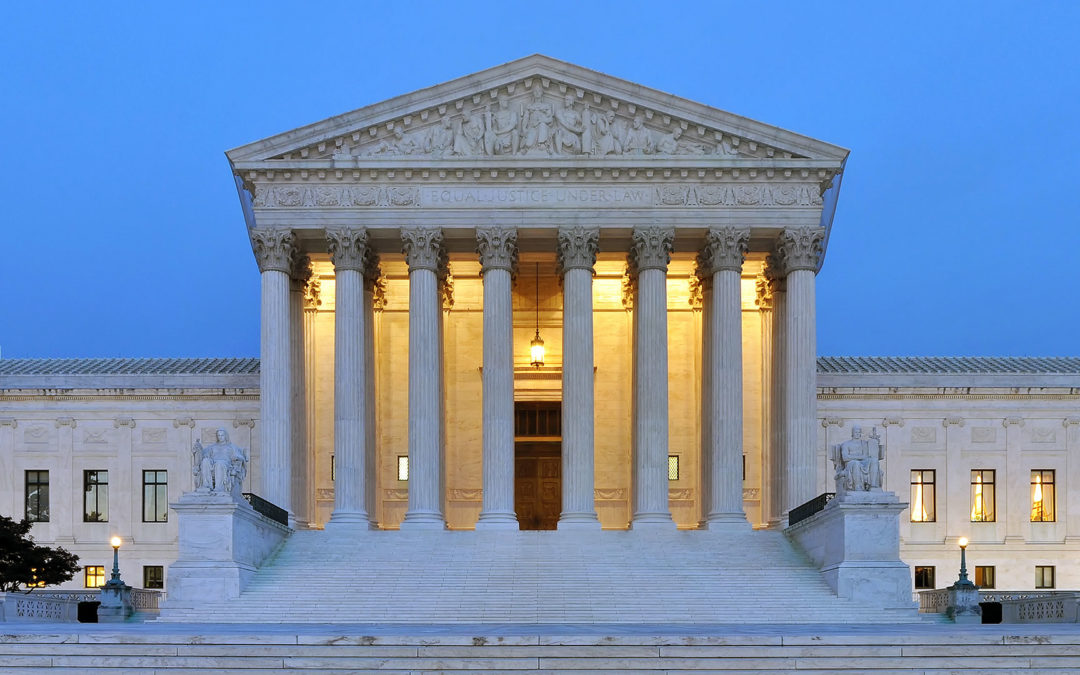The peculiarities of this Presidential election are highlighting the Supreme Court: Many say they’ll vote for Trump for no reason other than future federal judicial nominees.
This, in turn, has caused many pundits and even some learned scholars to toss out the old line that the judiciary is “the least dangerous branch.”
But almost always the reference to that line is wrong, usually in more ways than one, and usually for lack of reading carefully the ideas and arguments of thoughtful writers. So here’s some clarification, should anyone find it helpful.
THE FEDERALIST PAPERS
The line comes from the 78th number of The Federalist Papers. Here is the full sentence:
Whoever attentively considers the different departments of power must perceive, that, in a government in which they are separated from each other, the judiciary, from the nature of its functions, will always be the least dangerous to the political rights of the Constitution.
Why does The Federalist present the judiciary as the “least dangerous?” In part “because it will be least in a capacity to annoy or injure them.” Also, the judiciary lacks certain powers that the other two branches of government possess:
The Executive not only dispenses the honors, but holds the sword of the community. The legislature not only commands the purse, but prescribes the rules by which the duties and rights of every citizen are to be regulated.
This is why The Federalist concludes, at least provisionally, that:
The judiciary, on the contrary, has no influence over either the sword or the purse; no direction either of the strength or of the wealth of the society; and can take no active resolution whatever. It may truly be said to have neither FORCE nor WILL, but merely judgment; and must ultimately depend upon the aid of the executive arm even for the efficacy of its judgments.
JUDICIARY: LEAST DANGEROUS
This provisional conclusion is the one repeated by virtually everyone who has some superficial familiarity with The Federalist Papers. And certainly there’s some truth to it: There have been opinions handed down by the Supreme Court that were unenforced by the elected branches of government.
Think, as just an example, of the 1954 case Brown v. Board of Education. A full decade after the Court ruled that racial segregation in public schools is unconstitutional, many public schools remained racially segregated. In cases like that, the judiciary appears weak compared to the executive and legislative branches.
And insofar as “weak” means “not dangerous,” it seems the judicial branch of government is something citizens need not much fear.
But thoughtful, careful students know better. We notice subtle hints by the authors that they are offering a subtle, esoteric teaching that might be different than the surface or quick superficial reading of The Federalist Papers.
JUDICIARY: PERHAPS THERE’S MORE THAN FIRST APPEARS?
It turns out that the notion of the judiciary being the “least dangerous” branch of government that has “neither force nor will” is no conclusion at all, at least not in the context of the whole of The Federalist Papers.
The very next paragraph of Federalist 78 begins, “This simple view of the matter”—which suggests that the language about “least dangerous” and “neither force nor will” is a mere “simple view” of the judiciary.
Perhaps there’s a more nuanced, complex view—a view available only to those who read The Federalist Papers carefully while thinking through the many problems and challenges of constitutional self-government?
And from the more nuanced, complex point of view, perhaps the judiciary appears as much more powerful and, therefore, potentially dangerous?
Certainly no one can deny that while the Supreme Court has been unable to enforce some of its opinions, the Court has also re-shaped and transformed American politics, American government, American law, and even American culture in profound ways. Sometimes almost single-handedly. And often in ways not good. Just think: Dred Scott. Or Roe v. Wade.
INTERPRETING THE FEDERALIST
When one compares the assertion in Federalist 78 that the judiciary has “neither force nor will” with the rest of The Federalist Papers, certain problems, or what appears as contradictions, arise.
In number 51, for example, The Federalist argues that in order for constitutional separation of powers to be an effective, limiting check on government, “each department should have a will of its own.”
But what about the judiciary having “neither force nor will?”
The Federalist goes on to argue that each department of government, including the judiciary, should be filled with persons of ambition, because only then can “ambition…be made to counteract ambition.”
In other words: How can an ambitious President or ambitious members of Congress be checked by the judiciary? Why, only if the judiciary is staffed with ambitious men and women!
Certainly a judiciary staffed with ambition is a judiciary that can be, possibly, helpful when the elected branches are running roughshod over the equal natural rights of citizens, such as legislating one plan of socialism after another, or creating one unconstitutional controlling regulatory agency after another.
AND a judiciary staffed with ambition can also be a great danger to the equal natural rights of citizens, especially if those same citizens begin bowing in slavish obedience to everything the Court commands or thinking that there is no way to challenge or push back against a Court that authorizes the violation of the natural freedom of citizens rather than protecting it.
RHETORICAL STRATEGY: WALK LIKE A DEMOCRAT, TALK LIKE A DEMOCRAT
So why does The Federalist suggest in number 78 that the judiciary is the “least dangerous” branch, immediately followed by a comment that such a view is “simple,” while in other places the authors of The Federalist Papers hint that the judiciary, like every branch of government, has the potential to be quite dangerous?
For the same reason that the entire discussion of the judiciary was left to the near end of The Federalist Papers, after the much more “democratic” parts of the proposed national government were unveiled and discussed.
It’s no accident, after all, that in presenting the proposed Constitution of 1787 to a very democratic American people—an American people almost drunk on democracy, filled with pride in their ability to govern themselves, whether that pride was rooted more in actual history or democratic fantasies!—The Federalist authors were careful to emphasize first the House of Representatives, chosen directly by the people, then the Senate, then the Presidency, and lastly the judiciary: in order, from the most democratic to the least democratic part of the proposed Constitution.
The Federalist authors knew that the judiciary would be the most controversial part of the proposed Constitution because it’s thoroughly UN-democratic. Thus they began the book with common ground, attempting first to gain the trust and agreement of their American audience by showcasing the more democratic features of the Constitution they were asking and encouraging fellow citizens to ratify.
They saved discussions of the largely independent, UN-democratic judiciary (as well as the thoroughly principled but not popular argument against a bill of rights) for the very end of The Federalist Papers.
And why did the designers of the United States Constitution include a thoroughly UN-democratic judiciary? The answer is itself a highly problematic teaching for a democratic people to swallow: Namely, democracy is likely to lead to injustice in the form of majority tyranny.
It’s rare for democracy to coincide with justice in the form of equal protection of the laws for equal individual natural freedom and private property. And the authors of The Federalist Papers were all-too-aware of this fact rooted in human nature and displayed throughout human history.
HUMAN SELF-GOVERNMENT: ALWAYS RIGHT, ALWAYS PROBLEMATIC
The Federalist authors argued at length that freedom in the form of self-government is absolutely, naturally right for human beings. Why? Because no human being by nature is authorized to rule other human beings without their permission—not even those human beings who have titles such as King, Pharaoh, Caesar, Emperor, the Leader or der Führer, Regulator, Expert, or God.
AND, at the same time, The Federalist authors thought human self-government is always and everywhere highly problematic because human beings always and everywhere are tempted to use the power of government and superior democratic numbers to harass, intimidate, control, and steal from others.
They all knew that the greatest threat to the American people, ultimately, is…the American people. They knew that once a democratic people start voting to plunder their fellow citizens in the name of social justice or socialism or “free” housing, “free” education, “free” health care, etc, self-government becomes the problem, not the solution.
Democratic tyranny, after all, is still tyranny.
That’s why the authors of The Federalist and the designers of the Constitution wanted one part of the national government that’s insulated to a high degree from sheer democratic, majoritarian mob influence. That was the original purpose and hope for the judiciary: To secure the equal natural freedom and private property of all American citizens by upholding the United States Constitution against unjust, unconstitutional laws passed by greedy, democratic, mob majorities or their representatives.
THE ART OF WRITING FOR THE MANY AND THE FEW SIMULTANEOUSLY
A wise man remarked long ago, “If a master of the art of writing commits such blunders as would shame an intelligent high school boy, it is reasonable to assume that they are intentional, especially if the author discusses, however incidentally, the possibility of intentional blunders in writing.”
Certainly there are “blunders” within The Federalist Papers that would shame an intelligent school boy. The oft-quoted line about the judiciary being the “least dangerous” and the several places within the same book that contradict it are but a few examples.
Yet the authors of The Federalist, especially the mastermind behind the project, Alexander Hamilton, were masters of the art of the writing. And in more than one place, the authors of The Federalist Papers suggest that what they, themselves, wrote in “former papers” may not be “precisely true”—the authors of The Federalist Papers discuss, in other words, the possibility of intentional blunders in writing.
Thus it might be reasonable to assume that the blunders within The Federalist Papers are intentional, that certain passages appear simply to appease the democratic masses, while other passages, some which seem blatantly contradictory, contain ideas more important than mere cheerleading.
And, of course, The Federalist authors would not be the first or last to stroke the prejudices of their audience without actually sharing those prejudices. Wherever people hold strong beliefs or prejudices, one must pay tribute to those beliefs if one is to be persuasive.
There’s more, much more, to interpreting The Federalist Papers. It’s a master work of political philosophy, history, psychology, poetry, and marketing communications, all in one. But hopefully this little essay is sufficient to point out the kinds of problems that come from ripping part of a Federalist quotation out of context and parading it around as a sign of constitutional or literary sophistication.
It’s not sophistication.
It’s evidence of the ancient maxim that most people tend to be thoughtless, and thoughtless people tend to be careless readers. They see nothing beyond or behind the surface. Which means they retain only the superficial teachings that thoughtful men and careful writers want them to retain. The deeper teaching, the important teaching, the problematic and controversial and likely unpopular teaching—the search for what is TRUE rather than what is merely popular or merely pleasing—is the reserve of careful readers who are not thoughtless because they are thoughtful.

